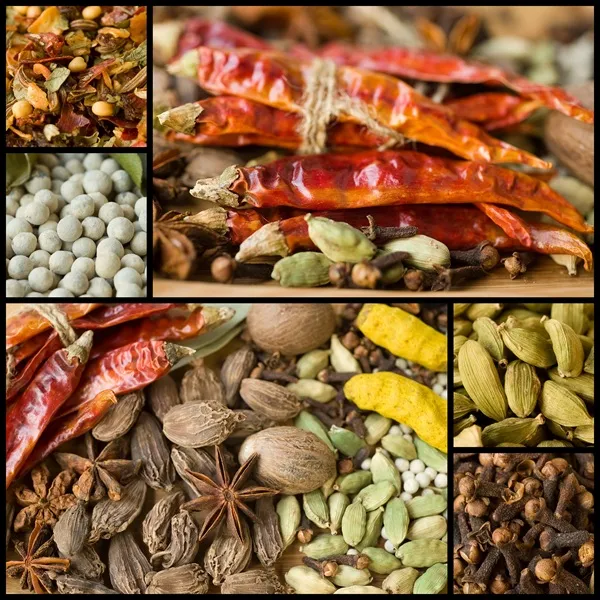Table of Contents
Chinese Spices: A Culinary and Cultural Odyssey – A Comprehensive Guide
Introduction
Chinese spices are the backbone of one of the world’s most intricate cuisines, offering a symphony of flavors and aromas. From the numbing heat of Sichuan pepper to the licorice-like sweetness of star anise, these spices have shaped regional dishes, traditional medicine, and global trade. This guide delves into their varieties, uses, cultivation, and economic impact.
1. Key Chinese Spices: Varieties & Tastes
China’s spice palette is vast, with each region boasting unique flavors:
- Sichuan Pepper (Huājiāo): Citrusy, numbing (from Zanthoxylum species).
- Star Anise (Bājiǎo): Sweet, licorice-like; key in five-spice powder.
- Cinnamon (Ròu Guì): Warm, woody (from Cinnamomum cassia).
- Cloves (Dīngxiāng): Pungent, sweet; used in braised meats.
- Fennel Seeds (Xiǎohuíxiāng): Mildly sweet, anise-like.
- Dried Tangerine Peel (Chénpí): Citrusy, bitter-sweet.
- Sand Ginger (Shā Jiāng): Earthy, camphor-like (used in Cantonese cuisine).
- White Pepper (Báihújiāo): Sharp, less fiery than black pepper.
2. Culinary Uses & Quick Recipes
- Sichuan Cuisine:
- Mapo Tofu: Ground pork, tofu, chili oil, and Sichuan pepper.
- Cantonese Roasts:
- Char Siu Pork: Star anise, cloves, and cinnamon in the glaze.
- Quick Recipes:
- Five-Spice Roasted Nuts: Toss nuts with five-spice powder, soy sauce, and honey; roast at 180°C for 15 mins.
- Ginger-Scallion Oil: Heat oil with minced ginger, garlic, and scallions; drizzle over noodles.
3. Nutritional & Health Benefits
- Sichuan Pepper: Contains hydroxy-alpha sanshool (anti-inflammatory).
- Star Anise: Rich in shikimic acid (used in Tamiflu production).
- Cinnamon: Lowers blood sugar levels (studies suggest).
- Ginger: Aids digestion and reduces nausea.
- General Benefits: Antioxidant-rich, antimicrobial, and digestion-enhancing properties.
4. Cultivation & Geography
- Sichuan Pepper: Grown in Sichuan/Yunnan’s mountainous regions (moderate rainfall, well-drained soil).
- Star Anise: Thrives in Guangxi’s humid subtropical climate.
- Cinnamon: Cultivated in Guangdong and Guangxi (tropical highlands).
- Climate Needs: Most spices require warm temperatures (15–30°C), high humidity, and partial shade.
5. By-Products & Processing
- Essential Oils: Sichuan pepper oil for aromatherapy; star anise oil in perfumes.
- Powders: Ground spices for convenience.
- Traditional Medicine: Clove oil for toothaches; dried tangerine peel in herbal teas.
- Sauces: Soy sauce, hoisin, and chili pastes infused with spices.
6. Storage & Preservation
- Dried Spices: Store in airtight containers away from light (1–2 years shelf life).
- Fresh Ginger/Garlic: Refrigerate in paper towels (2–3 weeks) or freeze minced portions (6 months).
- Avoid Moisture: Prevents mold and loss of potency.
7. Major Producers & Trade
- Top Producers:
- Sichuan/Yunnan: Sichuan pepper, sand ginger.
- Guangxi: Star anise (80% of global supply).
- Guangdong: Cinnamon, dried tangerine peel.
- Exporters: China dominates star anise and cinnamon exports; Vietnam and India are competitors.
- Importers: USA, EU, Japan, and Southeast Asia (for culinary and pharmaceutical use).
8. Home Planting Tips
- Ginger: Plant rhizomes in pots with well-drained soil; partial sunlight.
- Garlic: Separate cloves and plant in autumn; harvest in summer.
- Chili Peppers: Sunny spots, regular watering.
9. Pests & Challenges
- Common Pests:
- Root-Knot Nematodes (ginger).
- Aphids (cinnamon trees).
- Fungal Diseases (star anise in overly humid conditions).
- Solutions: Neem oil, crop rotation, and resistant cultivars.
10. Return on Investment (ROI)
- Costs:
- Sichuan Pepper: $2,000–$5,000/hectare (labor-intensive harvesting).
- Star Anise: Lower labor costs due to perennial growth.
- Profitability:
- Star anise: $8–$15/kg (high demand in pharma).
- Sichuan pepper: $10–$30/kg (premium export prices).
11. Sustainability & Innovations
- Organic Farming: Rising demand for pesticide-free spices.
- Agroforestry: Integrating spice trees with other crops (e.g., cinnamon with tea plants).
- Eco-Packaging: Biodegradable bags for exports.
12. Cultural & Historical Significance
- Ancient Trade: Spices like cassia were traded along the Silk Road.
- Traditional Medicine: Star anise in remedies for colds; ginger for digestion.
Conclusion
Chinese spices are more than flavor enhancers—they are a bridge between history, health, and culinary artistry. From the misty hills of Guangxi to bustling global kitchens, these spices continue to captivate palates and drive economies. Whether infusing a hot pot or healing a cold, their legacy is as enduring as it is aromatic.
Pro Tip: Toast whole spices lightly before grinding to unlock deeper flavors!
Savor the essence of China – one spice at a time. 🌶️🍃









